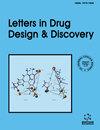Design, Synthesis, and Biological Evaluation of Some Novel Retinoid Derivatives
IF 1.6
4区 医学
Q4 CHEMISTRY, MEDICINAL
引用次数: 0
Abstract
Background:: As cancer stands as a significant global health concern, many heterocyclic compounds that are more effective in cancer cells than healthy cells are being investigated for their selective anticancer potentials. One such compound is fenretinide, a synthetic derivative of retinoic acid that has a broad spectrum of cytotoxic activity against primary tumor cells, cell lines, and/or xenografts of various cancers. In this context, bexarotene and its derivatives, synthesized from hybridization of the fenretinide, are expected to possess a potential anticancer activity. background: Cancer is currently the most prevalent disease. It is already known that the Fenretinide compound shows biological activity template. The Fenretinide compound is obtained as a result of the amidification of the retinoic acid with p-hydroxy aniline. The Bexarotene compound and its derivatives that will be obtained as a result of the hybridization of the Fenretinide compound are expected to show anticancer activity. Objective:: The objective of the present study was to investigate the synthesis of novel amid-derived and bexarotene-based compounds, as well as to assess their cytotoxic effects in different cancer cell lines. objective: The purpose of this study was to analyze the synthesis of novel amid-derived compounds based on Bexarotene and cytotoxic effects in different cancer tissues. Methods:: This study involved the synthesis of twelve novel retinoid derivatives (6-17) in a six-step process. The cytotoxic activities of these compounds were assessed against various cancer cell lines, such as A549 (human lung carcinoma), HeLa (human cervical cancer), MCF7 (human breast adenocarcinoma), and WiDr (human colon adenocarcinoma). The chemical structures of these compounds were elucidated through their elemental analysis, mass spectrometry (ESI+, ESI-), as well as 1H-NMR and 13C-NMR spectroscopic data. method: In this study, novel twelve retinoid derivatives (6-17) were synthesized in six steps. Cytotoxic activities of the compounds have been tested against human lung carcinoma cells (A549), human cervical cancer cells (HeLa), human breast adenocarcinoma (MCF7), and human colon adenocarcinoma cell line (WiDr). The chemical structures of the compounds were explained with their elemental analysis, mass (ESI+, ESI-), and 1H-NMR, 13C-NMR spectral data. Results:: The obtained cell toxicity results indicated that compounds 6, 8, 11, 12, 13, 14, and 17 were found to exhibit the strongest cytotoxic activity in above mentioned cancer cell lines. The IC50 values for active compounds, 11 and 12, were determined as 2.38μM and 2.29μM, respectively. Remarkably, these compounds displayed higher cytotoxic activity in the WiDr cell line related to positive control, camptothecin (CPT). Moreover, compounds 14 and 17 demonstrated very similar level of cytotoxic activity to CPT, indicating their potential for antitumoral applications upon further studies. result: According to the obtained cytotoxicity results, compounds 6, 8, 11, 12, 13, 14, and 17 were found to have the highest cytotoxic activity in 4 cancer cell lines. The IC 50 values for active compounds, 11 and 12 were shown as 2,38µM; and 2,29µM, respectively, and these compounds were determined higher cytotoxic activity in the WiDr colon cancer cell line than as a positive control CPT. The closest activity as a positive control CPT was observed in compounds 14 and 17 have the potential for antitumoral applications following further analysis. Conclusion:: While compounds 11, 12, 14, and 17 indicated a very comparable anticancer activity to CPT, compounds 6, 8, 11 and 12 showed more selective anticancer effect against cancer cells than noncancerous cells. In accordance with the findings of the present study, they can be evaluated as primary candidates for further studies, specifically as RXRα-targeted anticancer agents. other: Objective: The purpose of this study was to analyze the synthesis of novel amid-derived compounds based on Bexarotene and cytotoxic effects in different cancer tissues. Background: Cancer is currently the most prevalent disease. It is already known that the Fenretinide compound shows biological activity template. The Fenretinide compound is obtained as a result of the amidification of the retinoic acid with p-hydroxy aniline. The Bexarotene compound and its derivatives that will be obtained as a result of the hybridization of the Fenretinide compound are expected to show anticancer activity. Methods: In this study, novel twelve retinoid derivatives (6-17) were synthesized in six steps. Cytotoxic activities of the compounds have been tested against human lung carcinoma cells (A549), human cervical cancer cells (HeLa), human breast adenocarcinoma (MCF7), and human colon adenocarcinoma cell line (WiDr). The chemical structures of the compounds were explained with their elemental analysis, mass (ESI+, ESI-), and 1H-NMR, 13C-NMR spectral data. Results: According to the obtained cytotoxicity results, compounds 6, 8, 11, 12, 13, 14, and 17 were found to have the highest cytotoxic activity in 4 cancer cell lines. The IC 50 values for active compounds, 11 and 12 were shown as 2,38µM; and 2,29µM, respectively, and these compounds were determined higher cytotoxic activity in the WiDr colon cancer cell line than as a positive control CPT. The closest activity as a positive control CPT was observed in compounds 14 and 17 have the potential for antitumoral applications following further analysis. Conclusion: Considering the results in this study, the closest activity as a positive control CPT was observed in compounds 11, 12, 14, and 17 can be used as the lead compounds targeting RXRα for anticancer compounds for further studies.一些新型类维甲酸衍生物的设计、合成和生物学评价
背景:由于癌症是一个重大的全球健康问题,人们正在研究许多杂环化合物,它们在癌细胞中比健康细胞更有效,具有选择性抗癌潜力。其中一种化合物是芬维甲酸,它是维甲酸的合成衍生物,对各种癌症的原发肿瘤细胞、细胞系和/或异种移植物具有广谱的细胞毒性活性。在这种情况下,苯沙罗汀及其衍生物,由芬维甲酸的杂交合成,有望具有潜在的抗癌活性。背景:癌症是目前最普遍的疾病。目前已知芬瑞啶化合物具有生物活性模板。该芬维甲酸化合物是视黄酸与对羟基苯胺的酰胺化的结果。该苯沙罗汀化合物及其衍生物将由该苯沙罗汀化合物杂交得到,预计将显示出抗癌活性。目的:本研究的目的是研究新型中间体衍生化合物和贝沙罗汀基化合物的合成,并评估它们对不同癌细胞系的细胞毒性作用。目的:分析以贝沙罗汀为基础的新型中间体衍生化合物的合成及其在不同肿瘤组织中的细胞毒作用。方法:采用六步法合成12种新型类维甲酸衍生物(6-17)。这些化合物对各种癌细胞系的细胞毒活性进行了评估,如A549(人肺癌)、HeLa(人宫颈癌)、MCF7(人乳腺腺癌)和WiDr(人结肠腺癌)。通过元素分析、质谱分析(ESI+、ESI-)以及1H-NMR和13C-NMR数据对化合物的化学结构进行了鉴定。方法:本研究分6步合成了12种新的类维甲酸衍生物(6-17)。研究了化合物对人肺癌细胞(A549)、人宫颈癌细胞(HeLa)、人乳腺腺癌细胞(MCF7)和人结肠癌细胞系(WiDr)的细胞毒活性。通过元素分析、质量(ESI+、ESI-)和1H-NMR、13C-NMR谱数据对化合物的化学结构进行了解释。结果:细胞毒性实验结果表明,化合物6、8、11、12、13、14和17对上述肿瘤细胞系的细胞毒性最强。活性化合物11和12的IC50值分别为2.38μM和2.29μM。值得注意的是,这些化合物在与阳性对照喜树碱(CPT)相关的WiDr细胞系中显示出更高的细胞毒活性。此外,化合物14和17表现出与CPT非常相似的细胞毒活性,表明它们在进一步研究中具有抗肿瘤应用的潜力。结果:根据细胞毒性结果,化合物6、8、11、12、13、14、17对4种癌细胞的细胞毒活性最高。活性化合物11和12的IC 50值分别为2,38µM;和2,29µM,这些化合物在WiDr结肠癌细胞系中的细胞毒活性高于作为阳性对照的CPT。进一步分析发现,化合物14和17作为阳性对照CPT的活性最接近,具有抗肿瘤应用的潜力。结论:化合物11、12、14和17与CPT具有相当的抗癌活性,而化合物6、8、11和12对癌细胞的选择性抗癌作用强于非癌细胞。根据本研究的结果,它们可以作为进一步研究的主要候选物,特别是作为rxr α-靶向抗癌药物。目的:分析以贝沙罗汀为基础的新型中间体衍生化合物的合成及其对不同肿瘤组织的细胞毒作用。背景:癌症是目前最普遍的疾病。目前已知芬瑞啶化合物具有生物活性模板。该芬维甲酸化合物是视黄酸与对羟基苯胺的酰胺化的结果。该苯沙罗汀化合物及其衍生物将由该苯沙罗汀化合物杂交得到,预计将显示出抗癌活性。方法:本研究分6步合成了12种新的类维甲酸衍生物(6-17)。研究了化合物对人肺癌细胞(A549)、人宫颈癌细胞(HeLa)、人乳腺腺癌细胞(MCF7)和人结肠癌细胞系(WiDr)的细胞毒活性。通过元素分析、质量(ESI+、ESI-)和1H-NMR、13C-NMR谱数据对化合物的化学结构进行了解释。 结果:根据细胞毒性结果,化合物6、8、11、12、13、14、17对4种癌细胞的细胞毒活性最高。活性化合物11和12的IC 50值分别为2,38µM;和2,29µM,这些化合物在WiDr结肠癌细胞系中的细胞毒活性高于作为阳性对照的CPT。进一步分析发现,化合物14和17作为阳性对照CPT的活性最接近,具有抗肿瘤应用的潜力。结论:结合本研究结果,化合物11、12、14、17作为阳性对照CPT活性最接近,可作为靶向RXRα抗癌化合物的先导化合物进行进一步研究。
本文章由计算机程序翻译,如有差异,请以英文原文为准。
求助全文
约1分钟内获得全文
求助全文
来源期刊
CiteScore
1.80
自引率
10.00%
发文量
245
审稿时长
3 months
期刊介绍:
Aims & Scope
Letters in Drug Design & Discovery publishes letters, mini-reviews, highlights and guest edited thematic issues in all areas of rational drug design and discovery including medicinal chemistry, in-silico drug design, combinatorial chemistry, high-throughput screening, drug targets, and structure-activity relationships. The emphasis is on publishing quality papers very rapidly by taking full advantage of latest Internet technology for both submission and review of manuscripts. The online journal is an essential reading to all pharmaceutical scientists involved in research in drug design and discovery.

 求助内容:
求助内容: 应助结果提醒方式:
应助结果提醒方式:


